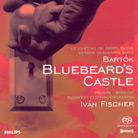April 2004
Bluebeard’s Castle was based on a play by Béla Balázs, a friend of Bartók’s mentor, Zoltán Kodály. There are only two characters, Duke Bluebeard and his new wife Judit. In spite of gossip and horrible accusation, Judit has married the Duke and accompanies him to his castle. Once there she discovers seven locked doors. She demands the keys to unlock them. One by one the doors reveal aspects of Bluebeard and his domain. Behind one door is his torture chamber, another conceals his wealth, still another covers the path to his vast land holdings. Opening the sixth door, Judit discovers a lake of tears. When she flings open the seventh door, Bluebeard’s three previous wives are there, not dead, as legend had broadcast, but enshrined in memory as the loves Bluebeard had met in the morning, at noon, and in the evening. Judit joins their rank as the fourth wife, the one met at midnight. The curtain comes down on Bluebeard alone, who weeps "Hence all shall be darkness, darkness, darkness." One could argue the symbolism in this opera well into a winter’s night. Judit sees blood on all the items hidden by the doors. Is it real or imagined? Bluebeard’s wives are shown as alive and well, in the closed doors of his heart. But why must Judit join them? Is it because she discovered his secret? Bartók’s music in this piece shows influences of Debussy, Wagner, and Richard Strauss, yet points the way to his later, folk-influenced composition style. The opera is arranged in a series of tableaux and the vocal parts move the action forward. There are no arias per se. The work lasts a mere hour, yet seems like a major composition. There have been good performances of Bluebeard’s Castle since the dawn of stereo, including one conducted by Ferenc Fricsay, which featured the young Dietrich Fischer-Dieskau and Hertha Töpper. A later, 1965 version conducted by István Kertész, cast with Walter Berry and Christa Ludwig, has become an audiophile classic of the Golden Age of stereo. Measured against these landmark recordings, this new one comes off very well. If the singers do not have the beautiful voices of Fischer-Dieskau or Ludwig, they do have a full measure of the drama of the piece. More important, Fischer leads a dynamic performance that exposes every element of drama and discovers each moment of lyricism. Then there is the sound. Though the Philips engineers have failed to take an opportunity for stage action up front, and perhaps some surround impact with those seven doors and the sighing effects in the orchestration, they have provided a rich and full recording that has awesome dynamic range and incredible clarity within an almost cavernous soundfield. When Judit opens the fifth door, the one that reveals the Count's domain, the full orchestra plays block chords in a hymn-like manner. In this recording, it is guaranteed to raise the hair on the back of a listener’s neck. There are other nice touches, including the use of a keyboard xylophone, the composer’s original choice (usually simulated by two xylophonists). The passage that includes it makes a good case for advanced-resolution reproduction. The CD layer seems restricted and far less alive when compared with either SACD recording. GO BACK TO: |
 Bartók - Bluebeard’s
Castle
Bartók - Bluebeard’s
Castle Last month, I reviewed a recording of Béla Bartók’s last
stage work, The Miraculous Mandarin. Bluebeard’s Castle was his
first, a two-character, one-act opera begun in 1911 and revised before its premiere in
1918. It was presented at that time as a double bill with the composer’s second work
for stage, the ballet The Wooden Prince.
Last month, I reviewed a recording of Béla Bartók’s last
stage work, The Miraculous Mandarin. Bluebeard’s Castle was his
first, a two-character, one-act opera begun in 1911 and revised before its premiere in
1918. It was presented at that time as a double bill with the composer’s second work
for stage, the ballet The Wooden Prince.